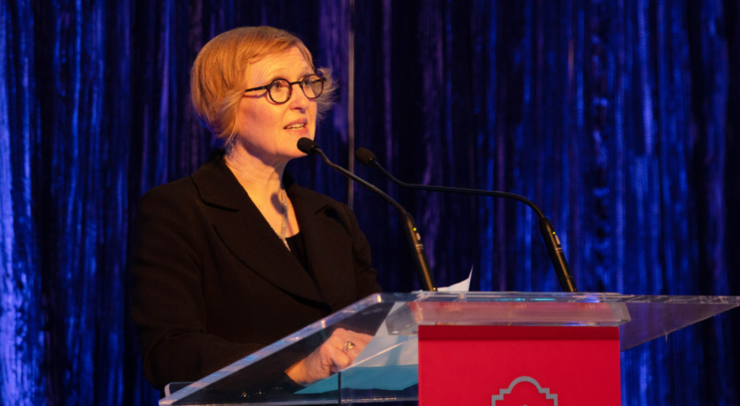Every course is designed to surprise and delight, pushing diners to be fully present in the moment.
A unique restaurant in the ByWard Market, “Dark Fork,” is redefining the dining experience by immersing its guests in complete darkness. Located at 25 George St., the restaurant offers a sensory adventure that allows patrons to engage with their meals in an entirely new way — without the visual cues they usually rely on. After contacting the restaurant, I booked both a reservation and an exclusive interview with the owner, Moe Alameddine.
My sister and I arrived at the location, where a friendly host greeted us and explained the dining process. In the foyer, we were given the menu and asked to choose our dishes before entering the dining room. Dark Fork offers a prix fixe menu, with two courses (main course and either a starter or dessert) priced at $46 per person, or three courses (starter, main course, and dessert) at $56. We were offered a surprise appetizer, followed by our choice of main course. I opted for the steak frites — a AAA Canadian sirloin with peppercorn sauce.
Guests are encouraged to select surprise dishes and drinks to enhance the mystery and excitement of the dining experience, as they must rely solely on their senses of taste, smell, and touch to guess what they’re eating.
After placing our orders, the host introduced us to our server, Dave, a visually impaired guide who would help us navigate the dining room. Dark Fork employs visually impaired servers who are accustomed to moving and functioning without visual cues, bringing a sense of expertise and confidence to the environment, making guests feel safe and comfortable despite the unusual circumstances.
Dave guided my sister and me to our table. The dining room was pitch black, with no light sources allowed — not even our phones. Soft, ambient music played in the background, creating a calming atmosphere that complemented the sensory immersion of the restaurant. Once seated, Dave described the layout of the table, ensuring we knew where everything was before he left.
When Dave returned, he brought our surprise appetizer, which we soon discovered was a garden salad. The lack of vision heightened the sensory experience, making flavours more pronounced, textures more intriguing, and scents more vivid. My sister and I spent time guessing the different vegetables in the salad with each bite.
Next, it was time for the main course. Using our knife and fork, we explored our plates, relying on touch and taste to identify what we were eating. The steak was prepared in small, bite-sized pieces, ensuring each bite was seamless. We found ourselves more attuned to our surroundings, noticing subtle details that we might have missed in a brightly lit setting. The steak was perfectly cooked to a medium-rare, while the fries were satisfyingly crunchy on the outside and soft and fluffy inside. As we ate, my sister and I engaged in lively conversation, deciphering the mystery elements of our dishes.
After dinner, I had the opportunity to sit down with Alameddine for an interview about the restaurant’s origins and inspiration.
The Fulcrum (TF): What inspired you to create a dining experience in the dark?
Moe Alameddine (MA): I was in Zurich in Switzerland. I saw the concept, and I brought it 18 years ago to Montreal in 2006.
TF: What do you hope diners will take away from their experience at “Dark and Fork?”
MA: To appreciate what you have for sights and vision.
TF: How do you think the absence of sight affects people’s perception of the food and drinks they enjoy at the restaurant?
MA: We don’t eat with our eyes, so it’s important to always use your other senses. You use the smell, the taste, you focus on the music, you listen, you hear the conversation with your partner, you know.
TF: Did you face any challenges creating this experience?
MA: Back 18 years ago? Yes, with the first location. Then, because I don’t have anyone blind in my family, I had to come up with techniques and to divide the sections and the tables and figure out where people need to walk around.
TF: How do you design a menu that works well in a setting where the food isn’t seen?
MA: We make it simple. For example, we cut the steaks with no bones, the fish, with no shells. We try to make it very safe for people. For pasta, usually we do small pasta, not like a long spaghetti, because it’s gonna be messy to eat it in the dark.
TF: How do you decide which dishes to offer as “surprise” options?
MA: It’s the chefs who decide. We usually focus on what’s the most popular dish we usually sell, and we take that same protein, and we try to make it as a surprise with a twist. It creates a lot of fun and a lot of curiosity. So people are like, “What am I eating?” They don’t even know, because even with the sauce, sometimes they get confused. Some people ask for a surprise drink too.
TF: How does your staff handle serving and assisting guests in such a unique environment?
MA: I try to hire people with vision loss, to help them, you know, to put them in this industry. That was one of the goals of my work, for sure, to break these barriers and challenges and just put them in at work in the restaurant. In this concept, they are the guide and we are the blind, that’s why we call it a transfer of trust. So we trust them to do the job for us.
By creating a space where diners must rely on senses other than sight, Alameddine has crafted a unique experience that challenges conventional dining norms while also highlighting the abilities of visually impaired individuals. It’s an invitation to slow down, savour each bite, and engage deeply with the moment, transforming a simple meal into an unforgettable sensory adventure.










